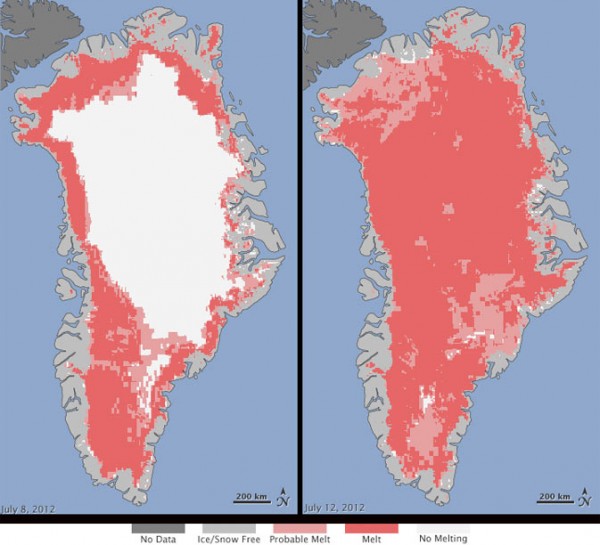In an announcement on July 24, 2012, NASA said that Greenland saw “unprecedented” ice sheet melting at the surface during a period of only four days in July. On July 8, 40% of Greenland was experiencing thawing at the surface. By July 12, nearly 97% of Greenland was experiencing surface thaw. The rate of melting at the surface is the largest ever recorded in the past 30 years, the time period during which satellites have observed Greenland ice. The measurements came from three independent satellites analyzed by NASA and university scientists. Their announcement said:
Nearly the entire ice cover of Greenland, from its thin, low-lying coastal edges to its 2-mile-thick (3.2-kilometer) center, experienced some degree of melting at its surface
What is causing the massive melt? Possibilities include oscillations in the weather, climate change, and natural variability in Earth’s cycles.

About half Greenland’s surface ice melts in an average summer. The Greenland ice sheet has been known to fluctuate – sometimes growing and sometimes melting – throughout history. This year, even the area around Summit Station in central Greenland – which at 2 miles (3.2 kilometers) above sea level is near the highest point of the ice sheet – showed signs of melting. Ice cores analyzed by Kaitlin Keegan at Dartmouth College in Hanover suggest that melting such as the one experienced this month has not occurred in Greenland since 1889.
The melting of Greenland’s surface ice could be cyclical and not relate to global warming.
North Atlantic Oscillation (NAO)

One large factor that greatly contributed to the rapid surface melting of Greenland had to do with ridging across the large island, that is, higher pressures in the region. Throughout late May and through July, the North Atlantic Oscillation, also called the NAO, has been in a negative state. When the NAO is negative, it typically means increased ridging across Greenland. When ridging occurs, pressures rise and thus provides more sunshine and warmer temperatures across the region. This process – which resulted in what climatologists call a heat dome – greatly influenced the melting across Greenland. A series of strong ridges over the region brought weather conducive for ice to melt.
Thomas Mote, a climatologist at the University of Georgia, Athens, was one of the scientists from around the U.S. who helped confirm the dramatic surface ice melting in Greenland in July 2012. He told me:
We saw a series of ridges move across the ice sheet, each one generally stronger than the previous. The ridge that formed over the ice sheet in mid-July was “pinched off” of the jet stream and stagnated over the ice sheet, resulting in a very warm period over the interior of the ice sheet. Preliminary numbers from NOAA suggest that June had the 3rd-most-negative NAO since 1950. Again, those conditions persisted at least into mid-July.
What about the role of global warming in this event? As of now, we cannot use global warming as the reason the ice melted so fast. As explained above, an unusually strong area of high pressure and a strong negative NAO had a lot to do with the melting of ice on the surface of Greenland. However, if this rare 150-year event occurs more frequently in the future, then it would make sense to believe that anthropogenic warming might be an influencing factor. As always, we cannot pinpoint a single weather event and shout out the term “Global Warming!” However, as time continues to pass, evidence is growing that the world we live in is becoming warmer. A large majority of climatologists agree the world is warming.
Greenland holds 680,000 cubic miles of ice, and if all of that ice were to melt completely, then the oceans would rise by more than 20 feet. Of course, there are no projections of this happening in the near future. However, by 2100, ocean levels could rise by two to six feet.
Watch this amazing video of meltwater in the Watson River at Kangerlussuaq, a settlement in western Greenland. This video was posted by the Kangerlussuaq Science Field School on July 12, 2012.











